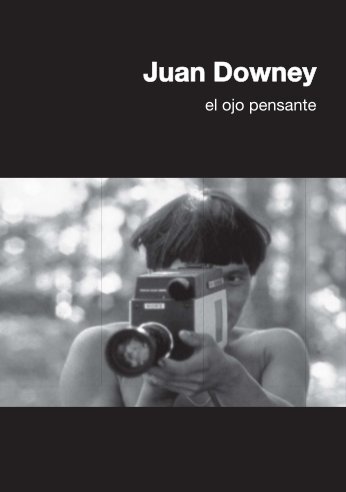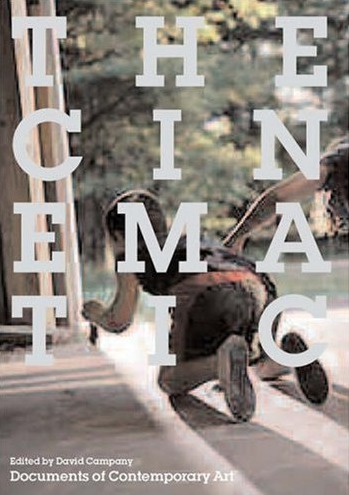Juan Downey: El ojo pensante / The Thinking Eye (2010) [Spanish/English]
Filed under catalogue | Tags: · art, art history, cybernetics, electronic art, photography, video, video art

Catalogue of the exhibition of a US-based Chilean pioneer video artist. During his career Downey created an extensive body of work that also includes electronic and video sculptures, photography, painting, drawing, printmaking, performance, installation and writing.
Curated by Julieta Gonzalez
Co-curated and Edited by Marilys Belt de Downey
Texts by Carla Macchiavello, Valerie Smith, Julieta Gonzalez, Nicolas Guagnini
227 pages
PDF (English section pp 173-217; 4 MB, updated on 2014-9-14)
Comment (0)David Campany (ed.): The Cinematic (2007)
Filed under book | Tags: · art history, cinema, contemporary art, film, film history, photography, video art

“The cinematic has been a springboard for the work of many influential artists, including Victor Burgin, Philip-Lorca diCorcia, Stan Douglas, Nan Goldin, Douglas Gordon, Cindy Sherman, and Jeff Wall, among others. Much recent cinema, meanwhile, is rich with references to contemporary photography. Video art has taken a photographic turn into pensive slowness; photography now has at its disposal the budgets and scale of cinema. This addition to Whitechapel’s Documents of Contemporary Art series surveys the rich history of creative interaction between the moving and the still photograph, tracing their ever-changing relationship since early modernism.
Still photography—cinema’s ghostly parent—was eclipsed by the medium of film, but also set free. The rise of cinema obliged photography to make a virtue of its own stillness. Film, on the other hand, envied the simplicity, the lightness, and the precision of photography. Russian Constructivist filmmakers considered avant-garde cinema as a sequence of graphic “shots”; their Bauhaus, Constructivist and Futurist photographer contemporaries assembled photographs into a form of cinema on the page. In response to the rise of popular cinema, Henri Cartier-Bresson exalted the “decisive moment” of the still photograph. In the 1950s, reportage photography began to explore the possibility of snatching filmic fragments. Since the 1960s, conceptual and postconceptual artists have explored the narrative enigmas of the found film still. The Cinematic assembles key writings by artists and theorists from the 1920s on—including László Moholy-Nagy, Pier Paolo Pasolini, Victor Burgin, Jeff Wall, and Catherine David—documenting the photography-film dialogue that has enriched both media.”
Contributors:
Roland Barthes, Jean Baudrillard, Raymond Bellour, Anton Giulio Bragaglia, Victor Burgin, Henri Cartier-Bresson, Catherine David, Thierry de Duve, Gilles Deleuze, Philip-Lorca diCorcia, Philippe Dubois, Régis Durand, Sergei Eisenstein, Mike Figgis, Hollis Frampton, Susanne Gaensheimer, Nan Goldin, Chris Marker, Christian Metz, Laura Mulvey, László Moholy-Nagy, Beaumont Newhall, Uriel Orlow, Pier Paolo Pasolini, Constance Penley, Richard Prince, Steve Reich, Carlo Rim, Raul Ruiz, Susan Sontag, Blake Stimson, Michael Tarantino, Agnès Varda, Jeff Wall, Andy Warhol, and Peter Wollen.
Publisher Whitechapel Art Gallery, London, 2007
Documents of Contemporary Art series
ISBN 0854881522, 9780854881529
221 pages
PDF (updated on 2022-11-29)
Comments (2)Yve Alain Bois, Rosalind E. Krauss: Formless: A User’s Guide (1996/1997)
Filed under book | Tags: · aesthetics, art, art criticism, art history, entropy, form, kitsch, painting, photography

“In a work that will become indispensable to anyone seriously interested in modern art, Yve-Alain Bois and Rosalind Krauss convincingly introduce a new constellation of concepts to our understanding of avant-garde and modernist art practices. Formless constitutes a decisive and dramatic transformation of the study of twentieth-century culture. Although it has been over sixty years since Georges Bataille undertook his philosophical development of the term informe, only in recent years has the idea of the “formless” been deployed in theorizing and reconfiguring the very field of twentieth-century art. This is partly because that field has most often been crudely set up as a battle between form and content, whereas “formless” constitutes a third term that stands outside the opposition of form and content, outside the binary thinking that is itself formal.
In Formless, Bois and Krauss, two of the most influential and respected art historians of our time, present a rich and compelling panorama of the formless. They map out its persistence within a history of modernism that has always repressed it in the interest of privileging formal mastery, and they assess its destiny within current artistic production. In the domain of practice, they analyze it as an operational tool, the structural cunning of which has repeatedly been suppressed in the service of a thematics of art. Neither theme nor form, formless is, as Bataille himself expressed it, a “job.” The job of Formless is to explore the power of the informe. A stunning new map of twentieth-century art emerges from this innovative reconceptualization and from the brilliantly original analyses of the work of Jackson Pollock, Andy Warhol, Cy Twombly, Lucio Fontana, Cindy Sherman, Claes Oldenburg, Jean Dubuffet, Robert Smithson, and Gordon Matta-Clark, among others.”
First published as L’Informe: mode d’emploi, Centre Georges Pompidou, Paris, 1996.
Publisher Zone Books, 1997
ISBN 0942299434, 9780942299434
304 pages
PDF (updated on 2013-1-15)
Comments (3)
